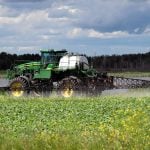NEW ORLEANS, La. (Staff) — The bread on your plate will always be made out of wheat.
But if Paul O’Connell has his way, so will the knife you butter it with, the table you sit at when you eat it and even the walls of the house you’re living in.
O’Connell, who is in charge of a U.S. government agency that’s looking for non-traditional, non-food uses for agricultural products, told U.S. wheat farmers last week that it’s time they started looking beyond the dinner table for markets to sell their product.
Read Also

Fall rye hits record high in Manitoba
Winter cereals 2025: More Manitoba fields grew fall rye in 2025 than ever before, but winter wheat slipped and, while spring stand survival was good, drought took its toll
“There are all sorts of new opportunities for industrial uses for wheat,” he told the annual convention of the U.S. National Association of Wheat Growers (NAWG).
“But you wheat growers have not really gotten on board like the other commodity groups have.”
O’Connell is director of the Alternative Agriculture Research and Commercialization Centre, a branch of the U.S. department of agriculture.
It spent $10 million (U.S.) of taxpayers’ money last year, matched by $25 million from the private sector, on 23 projects aimed at developing new, and sometimes surprising, uses for 20 different farm products.
Included among those projects were fiberboard, corrugated boxes and wallboard made from wheat straw, windshield washer fluid made from starch, film and coatings made from wheat gluten and “plastic” forks made from starch.
O’Connell said there are a number of reasons that wheat farmers should be looking for something to do with their product other than making bread.
Supply exceeds demand
Domestic wheat consumption in the U.S. continues to fall farther behind production, creating “serious overcapacity.” On the export side, the U.S. share of a stagnant world market actually declined in the 1980s.
At the same time, an expanding interest among consumers in environmental issues and biodegradable products has created a market for plant and animal-based manufacturing.
But there are barriers, particularly a lack of communication between the researchers and the people who would actually put products on the market.
“We have the world’s best researchers and facilities, but we’re not transferring that to production,” he said.














